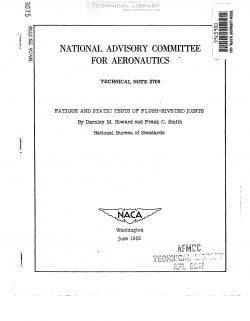naca-tn-2709
- Version
- 193 Downloads
- 1.16 MB File Size
- 1 File Count
- December 16, 2016 Create Date
- December 16, 2016 Last Updated
National Advisory Committee for Aeronautics, Technical Notes - Fatigue and Static Tests of Flush Riveted Joints

Fatigue tests at zero mean load were made on 190 multiple-rivet
joints having l/8-inch-diameter Al7S—T3 lOOo countersunk—head rivets.
Some of the joints had machine—countersunk holes and some had dimpled
holes. The joints had three rivets at 1-inch pitch or six rivets at
l/2-inch pitch. Both butt and lap joints were tested; Static tests were
made on 3h typical joints. The sheet materials used were 0.032—inch-
thick bare and alclad 75S-T6 sheet, 0.032-inch-thick bare and alclad ens—T3
sheet, and 0.06h—inch—thick alclad 75S—T6 sheet.
Joints made by dimpling showed marked superiority ifi both fatigue
and static strengths to those made by machine countersinking. Joints of
alclad sheets using machine-countersunk holes had greater fatigue stre h
than similar joints of bare sheets. Lap and butt joints, using machine—
countersunk holes, had nearly equal strength under static loads; while
the lap joints were superior under fatigue loads;
A photomicrograph of an 0.032—inch lap joint of alclad 2hS-T3 sheet .
using machine-countersunk holes, tested at a load slightly over that
needed to cause a permanent slip of h percent of the rivet hole diameter,
showed substantial gouging of the rivet by the sharp edge of the sheet.
Another photomicrograph of a dimpled joint of 753-T6 sheet showed that
the fatigue cracks tended to pr0pagate through heavily cold-worked
material.
The relationships between measured static prOperties of lap joints
and fatigue life for the four materials are given. No satisfactory single
relation between static prOperties and fatigue life covering the four
materials could be found.
A large amount of work has been done on the fatigue strength of
riveted joints. A comprehensive list of references to work done prior
to l9h6 is given by Jackson, Grover, and MCMaster on page 15% of
reference l. They state, "Many investigators have found that machine—
countersunk rivets produce weaker Joints than plain dimpled or press—
countersunk riveted Joints."
More recent work on the fatigue strength of riveted joints is
described in references 2, 3, and h. Reference 2 gives the results of
tests to shOW'the effects of notches, type of Joint, temperature, mate-
rial, Joint configuration, and ratio of maximum to minimum stress on the
fatigue life. Reference 3 gives fatigue test results with completely
reversed stresses for joints using single 3/16-inch-diameter EMS-T31 rivets
in a variety of sheet materials. No one sheet alloy shows consistent
superiority in the tests of reference 3, though alclad ens-T3 is generally
on the high side of the group.
| File | Action |
|---|---|
| naca-tn-2709 Fatigue and Static Tests of Flush Riveted Joints.pdf | Download |

Comment On This Post